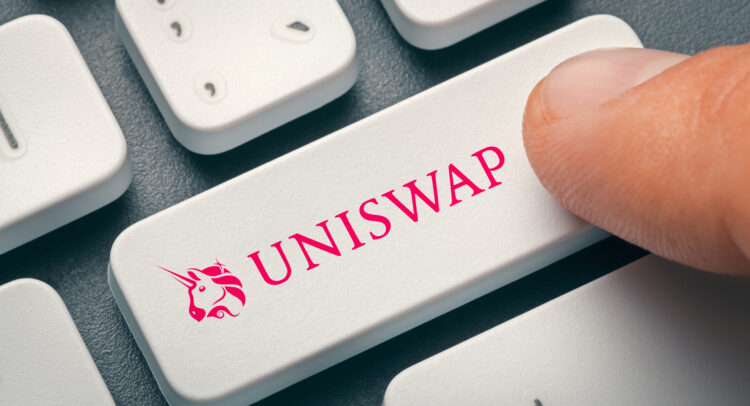Uniswap (UNI-USD), the original pioneer of the decentralized finance (DeFi) and decentralized exchange (DEX) space, is holding its rightfully-earned position as the king of DeFi.
Elevate Your Investing Strategy:
- Take advantage of TipRanks Premium at 50% off! Unlock powerful investing tools, advanced data, and expert analyst insights to help you invest with confidence.

It is still by far the largest DEX (decentralized exchange) by volume at $8.45 billion weekly, while its closest competitor, PancakeSwap, sits at just $2.91 billion. Its volume for the ETH/USDC pair alone rivals that of Binance (BNB-USD) and would place squarely in the top five markets for Ether trading.
An important sign of its strong position is its recent success on Arbitrum. After a slow start, Uniswap V3 became the top DEX on the chain by total value locked (TVL) and second overall after GMX (a perpetual futures platform).
Uniswap’s inability to gain significant traction on networks outside of Ethereum (ETH-USD) was a significant source of concern for its continued dominance. By taking Arbitrum by storm, which is now among the strongest blockchains for DeFi activity, Uniswap sent a message that the king is still there and still powerful.
Its recent deployment on BSC, the Binance-backed blockchain, shows promise with steady growth to $18 million TVL. Though still small by BSC standards, this encroachment on PancakeSwap, its largest competitor, is certainly worth keeping an eye on.
All of this success comes off the back of Uniswap V3, the first concentrated liquidity DEX that improved swap efficiency by 10x or more compared to anything else on the market (including its previous Uniswap V2, which has since become the dominant DEX smart contract system).
All Eyes on Uniswap V4?
Now, though, the license blocking Uniswap V3 from being forked expired, so a number of copycats quickly popped up. Though there are consistent rumors of an upcoming Uniswap V4, there’s reason to believe that it won’t be as much of a game-changer as V3.
A large reason why is that there’s simply nowhere else to go. Uniswap V3 allows pretty much arbitrary efficiency of liquidity pools, and the “max strength” setting is already being used to swap between different stablecoin wrappers. After a certain point, the liquidity providers just wouldn’t be able to keep up.
Furthermore, we’re seeing active steps of Uniswap going for a vertical integration approach with the recent launch of the Uniswap Wallet. Most likely, the vision behind such a strategy is to become a kind of “Crypto Robinhood” where users have a great mobile interface for trading on the exchange. At that point, usability concerns such as Miner Extractable Value (MEV) and automation become more important.
MEV is the bane of on-chain trading. Since every trade is visible and every trade is a market order, bots will often conduct front-running attacks, also known as sandwiching. This involves quickly placing a transaction before the victim’s, buying or selling so that the user gets a worse price. They then close the trade by swapping right after the victim, pocketing the difference at the expense of regular users.
Thus, it’s more likely that a hypothetical Uniswap V4 will focus more on tackling MEV and general usability, for example, by adding different order types. This is, for now, all speculation, and the truth is that a V4 is not necessary — the competition is so stale that their best move is to copy Uniswap’s tech two years later. Why would users choose these platforms over the original?
The Big Regulatory Elephant in the Room for UNI
Despite Uniswap’s success, its governance token UNI remains a questionable purchase. The primary reason for that is that UNI does virtually nothing.
The Uniswap decentralized autonomous organization (DAO), governed by UNI holders, earns nothing from its platform, and in the three years of its existence, it’s never done anything to change this. In theory, it could earn about 16.6% of every fee paid by Uniswap users, but this fee switch has never been activated.
The primary reason has to do with regulation. As the largest DEX with a team mostly based in the United States, anything Uniswap does will be greatly scrutinized by the Securities and Exchange Commission (SEC). And turning the fee switch may build a legal case that Uniswap is benefiting from the exchange of alleged securities on the platform, which would be illegal.
What’s worse, the SEC has greatly ramped up its enforcement actions recently. It’s sent a Wells Notice to Coinbase (NASDAQ:COIN), basically a letter warning that it is planning an enforcement action. It has served a subpoena to Sushi, Uniswap’s competitor. And there are justifiable rumors that if Uniswap hasn’t already received similar letters, it will soon. It’s easy to see how this is the worst possible moment to activate that switch.
So, while the Uniswap platform as a whole seems to have a bright future, even in the case of crypto crackdowns (it’s immutable), the UNI token may not fare so well. The chances of regulatory black swans are high, and until they’re cleared, UNI will not have proper tokenomics. We’re all waiting in anticipation, and the bull case for UNI may just begin right after one of these swans shows itself.
















